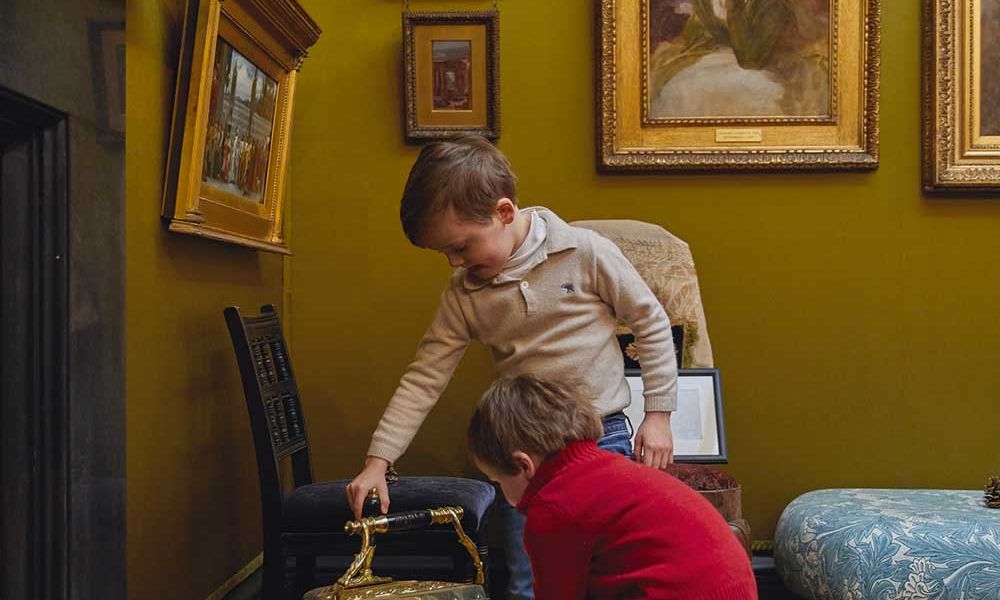Children looking at the Victorian brass coal scuttle in the Silk Room at Leighton House
© Janie Airey
• Read about the museums shortlisted for the Art Fund Museum of the Year 2023 here
When Leighton house, a museum created in the sumptuous London home of the Victorian artist Frederic, Lord Leighton, reopened last October after a two-year £9.6m rebuild, the first change the staff noticed was the sound.
“As we come down the staircase from our offices, we hear cups clattering in the café and people chatting. On school group days, it’s the sound of children playing,” says senior curator Daniel Robbins. “It’s completely different from the old rather solemn atmosphere, and it’s delightful.”
Since last October, more than 50,000 visitors have bought tickets for the main museum, exceeding the targets set for a whole year. Over fifty percent of those visiting were coming for the first time.
The refurbished wing, designed by architects BDP, added 43% new space and was funded by a £2.2m Heritage Lottery grant, £1.8m through friends of the museum and £5.6m from Kensington and Chelsea council. Within the shell of an unprepossessing 1920s addition to the house there is now a new reception area, shop, gallery, café, toilets, education space and a lift which allows disabled access to the entire building for the first time.
There’s a handsome gallery currently housing Evelyn De Morgan’s extraordinary gold paintings, gorgeous William De Morgan ceramics in the café and a film on major Victorian artists’ homes. A case in the reception area holds a precious new acquisition, the colour sketch for Leighton’s most famous painting, the swooning heat haze of Flaming June (1895). All of the new walls are painted in dark rich colours, echoing the palette of the house itself, to the initial consternation of the architects who envisaged a modish white box, according to Robbins.
Oneness, a mural by the Iranian artist Shahrzad Ghaffari
© Janie Airey
Visitors taking the new spiral stairs find they are actually inside another work of art. Oneness is an 11-metre-high mural by the Iranian artist Shahrzad Ghaffari, a swirl of calligraphy inspired by a 13th-century Rumi poem. Its evocation of cultural unity echoes Robbins’s aspirations to welcome all ages, faiths and social backgrounds. New work includes furniture by exiled Syrian workers and Kheit by textile artist Nour Hage.
The impact of the new spaces is immediately clear: local workers are bringing lunch into the garden, friends from distant parts of London meet there and families come in after school pick-up.
Leighton, born in Scarborough in 1830 into a wealthy medical family, was only permitted to train as an artist on condition of becoming “eminent”. He more than fulfilled that ambition, selling a canvas to Queen Victoria aged 25 and becoming one of the most famous artists of his generation. He became President of the Royal Academy and was the first artist to be given a peerage.
Visitors marvel at the Arab Hall, precisely the effect intended by Leighton and his architect George Aitchison. Its walls are lined with priceless tiles and mosaics under a golden dome, surrounding a fountain tinkling into a marble pool. Friends including De Morgan and designer Walter Crane helped create a suitable setting for spectacular 16th- and 17th-century tiles from Syria and Iran. The expensive addition to the relatively modest house was a sensation when it opened in 1882. Leighton said he built it “for the sake of something beautiful to look at once in a while”.
Victorians would never have seen what astonishes modern visitors: Leighton’s narrow bed. Only one unmarried friend, a young Italian painter, is ever known to have stayed the night, and despite Leighton’s close friendship with actress Dorothy Dene, the model in some of his most voluptuous paintings, Robbins has never found any evidence of Leighton having a sexual relationship. His last words were spoken from that narrow bed to his sisters, who then destroyed all his private papers. This seductive house still holds the secrets of the most public and private of Victorian artists.
Local schoolchildren enjoy the garden
© RBKC/Amira Ibrahim
Daniel Robbins, senior curator at Leighton House: A key driver of our project was to change the museum’s relationship to our local community. The refurbished wing is free to enter, as is the garden beyond. This large and beautiful space is now immediately visible through the floor-to-ceiling glazing of the café as visitors first enter. With direct access also provided from the Learning Centre, the garden has immediately become a focus for community activity. Schools have been planting beds and exploring ecology, biology and botanical drawing. The garden also provides a magical setting for weekend activity sessions.

